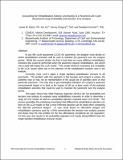| dc.contributor.author | Mack, James W. | |
| dc.contributor.author | Xu, Xin | |
| dc.contributor.author | Gregory, Jeremy | |
| dc.contributor.author | Kirchain, Randolph | |
| dc.date.accessioned | 2017-08-01T14:46:14Z | |
| dc.date.available | 2017-08-01T14:46:14Z | |
| dc.date.issued | 2015-08-12 | |
| dc.identifier.uri | http://hdl.handle.net/1721.1/110895 | |
| dc.description.abstract | In any life cycle assessment (LCA) for pavements, the designer must decide on which rehabilitation activities will be used to maintain the pavement over the analysis period. While this sounds simple, the fact is that there are many different rehabilitation scenarios that could be performed when the pavement requires rehabilitation, and which one is used will impact the LCA results. This creates inherent uncertainty and variability in the LCA results solely due to the selection of the rehabilitation scenario used in the analysis.
Currently, most LCA’s apply a single standard rehabilitation scenario to all pavements. The problem with this approach is that because each project is unique, the activities may or may not be representative of the actual set of activities done on that particular pavement. The only way to get meaningful indication of a project’s pavement environmental impact is to look at the impact of all (or at least most) of the potential rehabilitation activities that could be used to maintain the pavement over the analysis period.
This paper shows how State Highway Agencies (SHAs) can use probability and decision tree analysis to evaluate many rehabilitation scenarios in order to determine a range of LCA results, as well as a probability adjusted, expected value LCA result. This process quantifies the underlying uncertainty that different the rehabilitation selection can have on the LCA results so that a more informed decision can be made when comparing the alternate pavement designs. A case study based on alternative designs and rehabilitation scenarios used by a SHA demonstrates the decision tree analysis process and shows how the risk profiles for the two alternatives considered are not equivalent. For this case, this results in the probability-adjusted LCA results being different than the single standard rehabilitation scenario results. | en_US |
| dc.description.sponsorship | CSHub@MIT research is carried out with sponsorship provided by the Portland Cement Association and the Ready Mixed Concrete Research & Education Foundation. | en_US |
| dc.language.iso | en | en_US |
| dc.publisher | National Ready Mixed Concrete Association | en_US |
| dc.subject | Life Cycle Assessment | en_US |
| dc.subject | Pavements | en_US |
| dc.subject | Asset management | en_US |
| dc.subject | Infrastructure | en_US |
| dc.title | Accounting for Rehabilitation Activity Uncertainty in a Pavement Life Cycle Assessment using Probability and Decision Tree Analysis | en_US |
| dc.type | Other | en_US |
| dc.identifier.citation | J. Mack, J. Gregory, R. Kirchain, “Accounting for Rehabilitation Activity Uncertainty in a Pavement Life Cycle Assessment using Probability and Decision Tree Analysis”, Proceedings of the International Concrete Sustainability Conference, Miami, FL, May 11-13, 2015 | en_US |
| dc.contributor.department | Massachusetts Institute of Technology. Department of Civil and Environmental Engineering | |
